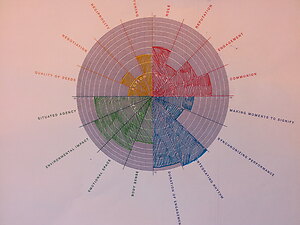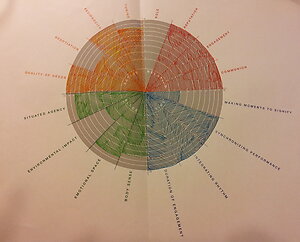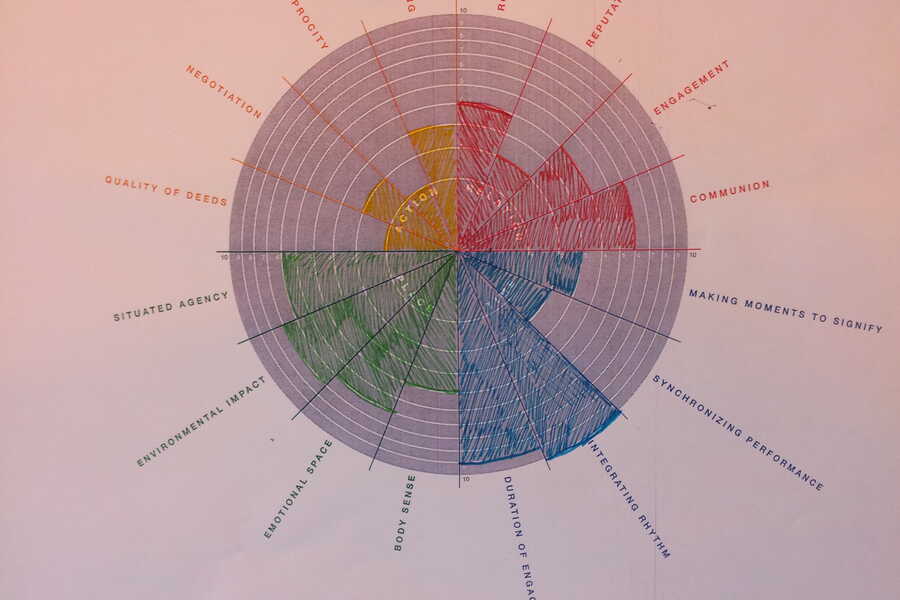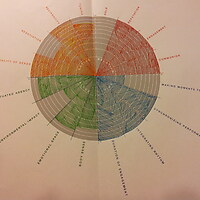
Figure 1. YUTPA for the current mobility system.

Figure 2. YUTPA for the future mobility system.
This week we made an additional YUTPA analysis, but this time for the current subsystem (figure 1).
As the figures show, our future subsystem (figure 2) focuses a lot on increasing reputation, engagement and communion. We think that these parts are important for Texel, since the identity of Texelaars and their independence is a very strong driving force (Frantzeskaki , Avelino , & Loorbach , 2013). Currently, we believe that the role plays too big a part, and that it should be reduced for the mobility system. Everyone should be treated as equals. We would also very much like to increase reciprocity and quality of deeds within the mobility system. Another striking change that we would like to see happen is that the synchronizing performance of the future system is more obvious than we believe it currently is. Also, we would like the environmental impact to be reduced.
As we did this, we tried to focus on what was important to the Texelaar. What is vital to them? Making a YUTPA anaysis for the current subsystem is extremely difficult, since neither of us are from Texel and can understand their viewpoint completely. A behaviour analysis would have been intereseting to perform on the island, but it falls outside of the scope for this subject.
How can we make this transitions happen then? Well, Solomon and Krishna (2011) say that since most energy transitions take a long time, accomplishing it in just a few years might cause a struggle. They believe that governmental support is important and that it can really help a project. Their example is from the ethanol case in Brazil, where the Brazilian government gave support by subsidizing and funding R&D (research and development). Mulder (2013) argues that innovation is extremely important, and that it can fuel the struggle towards becoming more sustainable. However, to not end up in “the valley of death” where innovations lack support and cannot be brought into society, there needs to be actors present who can support such innovation. Mulder also writes about changing complete technological systems, and not just parts. For example, maybe the car in itself is not contributing to an unsustainable world, but the system in which the car operates; economy, politics, social relations and so forth (Mulder, 2013).
This is interesting for our research. How can we try to change the entire mobility system, without losing track and focusing too much on individual technological parts? Sure, we need to think about innovations that can trigger a more sustainable mobility system. But we also need to make sure that we do not zoom in too much, so as to keep our perspective on the entire system which mobility is a part of.
References
Frantzeskaki , N., Avelino , F., & Loorbach , D. (2013). Outliers or Frontrunners? Exploring the (Self-) Governance of Community- Owned Sustainable Energy in Scotland and the Netherlands . in Renewable Energy Governance (pp. 101-116). London: Springer-Verlag.
Mulder, K. F. (2013). Strategies for Sustainable Technologies: Innovation in Systems, Products, and Services . in Handbook of sustainable engineering (pp. 881-894). Dordrecht: Springer Science+Business media.
Solomon, B. D., & Krishna , K. (2011). The coming sustainable energy transition: History, strategies, and outlook. Energy policy (39), pp. 7422–7431.



